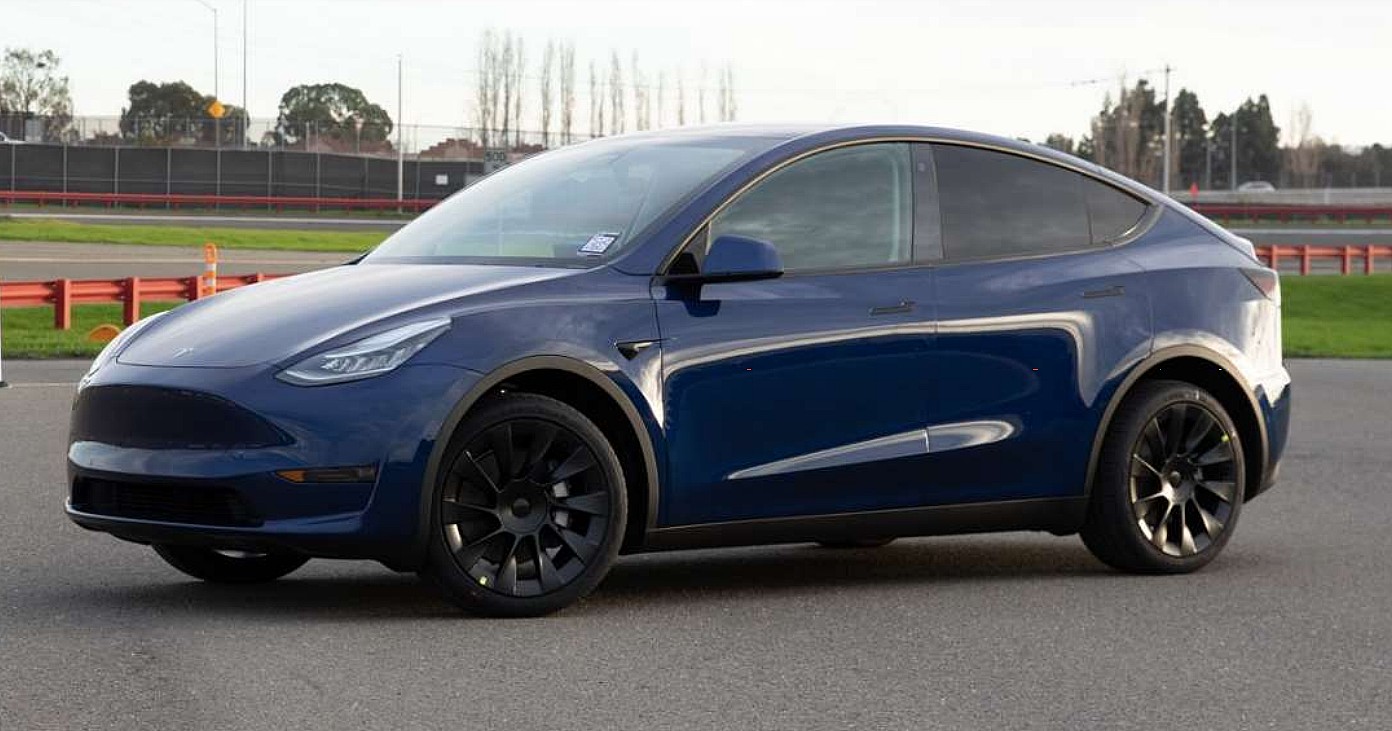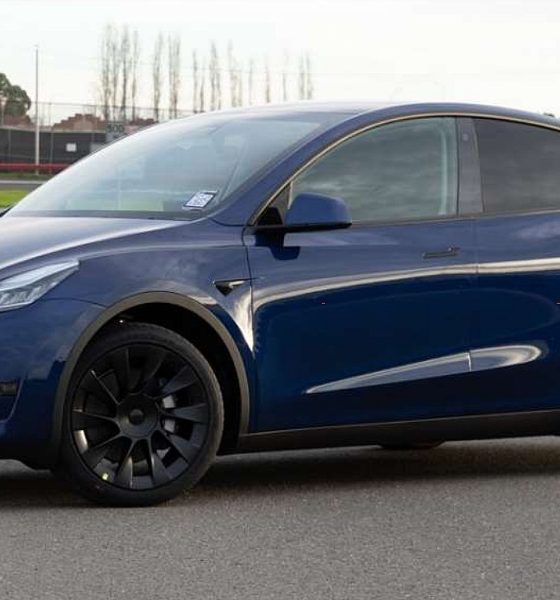

News
Tesla Model Y delivery date confirmed by California buyer, first deliveries earlier than expected
A Tesla Model Y buyer has reportedly received confirmation that their vehicle will be ready for delivery on Wednesday, March 11, a timeframe four days earlier than the widely anticipated March 15 first delivery date.
Updated March 11: Tesla Model Y first deliveries are scheduled for Friday, March 13
Updated March 7: The source that reported a March 11 delivery date has retracted their original statement. Teslarati is in contact with additional sources whom indicate Tesla employees are being offered first access to Model Y. An update will be provided as we learn more about the first Model Y delivery dates.
According to redditor and alleged soon-to-be Model Y owner u/HIP2013, a Tesla representative called them to schedule a pick up of their Model Y on Wednesday, 4 p.m. at the Rocklin showroom in California, about a 30-minute drive north from Sacramento and 2 hours from Tesla’ Fremont factory.
“Well I’m giving my Model 3 to my wife who is selling her Civic and I’m putting that money toward the Model Y,” u/HIP2013 wrote on the Tesla Motors channel on Reddit. “I should mention, when I first got the first email last week I got back to them in less than one hour with everything they asked for (insurance, payment info, etc).”
According to u/HIP2013, he reserved the Model Y even before the unveiling event livestream in March 2019. “I have reason to believe I may have been the first to reserve one,” they wrote. “…it seems like yesterday that I was making my order. I was in the first 5,000 to get my Model 3, so I’ve been part of the tribe for a while.”
The strong push of Tesla to make deliveries of the Model Y bode well for the finances of the company. Tesla aims to deliver 500,000 vehicles in 2020, a big jump from last year’s approximately 368,000 units. The Q1 end of quarter push would help cushion whatever effect the coronavirus outbreak has had on its sales.
On Thursday, Tesla started releasing the first batch of Tesla Model Y VINs ahead of the expected deliveries. Buyers in California, New York, Florida, Georgia and other parts of the United States started finding references to their vehicle’s identification number on their online purchase agreement.
Tesla Model Y images were also discovered in the latest version of the Android mobile app of the electric carmaker, a sign that Tesla is gearing up for the deliveries and suggesting that Model Y owners will enjoy the same functionality of the mobile app just as how owners of Model 3, Model X, and Model S do.
Tesla Model Y buyers first reported of receiving delivery confirmation emails two weeks ago where the carmaker asked customers to confirm their availability and complete any remaining steps of the purchase.
Tesla early delivery of the Model Y says a lot how the carmaker has matured through the years. While the Model Y might share about 75% of the Model 3’s DNA, Elon Musk has earlier said that its manufacturing process involves advanced techniques. The Tesla CEO also bets big time on the Model Y and believes the more affordable SUV will be a big hit and may become more popular than other vehicles on its line-up combined.
Are you a Tesla Model Y buyer or soon-to-be buyer? Join the poll below!
I’m a Tesla #ModelY buyer/soon-to-be buyer and…
— Teslarati Team (@TeslaratiTeam) March 8, 2020

News
Tesla (TSLA) receives “Buy” rating and $551 PT from Canaccord Genuity
He also maintained a “Buy” rating for TSLA stock over the company’s improving long-term outlook, which is driven by autonomy and robotics.

Canaccord Genuity analyst George Gianarikas raised his Tesla (NASDAQ:TSLA) price target from $482 to $551. He also maintained a “Buy” rating for TSLA stock over the company’s improving long-term outlook, which is driven by autonomy and robotics.
The analyst’s updated note
Gianarikas lowered his 4Q25 delivery estimates but pointed to several positive factors in the Tesla story. He noted that EV adoption in emerging markets is gaining pace, and progress in FSD and the Robotaxi rollout in 2026 represent major upside drivers. Further progress in the Optimus program next year could also add more momentum for the electric vehicle maker.
“Overall, yes, 4Q25 delivery expectations are being revised lower. However, the reset in the US EV market is laying the groundwork for a more durable and attractive long-term demand environment.
“At the same time, EV penetration in emerging markets is accelerating, reinforcing Tesla’s potential multi‑year growth runway beyond the US. Global progress in FSD and the anticipated rollout of a larger robotaxi fleet in 2026 are increasingly important components of the Tesla equity story and could provide sentiment tailwinds,” the analyst wrote.
Tesla’s busy 2026
The upcoming year would be a busy one for Tesla, considering the company’s plans and targets. The autonomous two-seat Cybercab has been confirmed to start production sometime in Q2 2026, as per Elon Musk during the 2025 Annual Shareholder Meeting.
Apart from this, Tesla is also expected to unveil the next-generation Roadster on April 1, 2026. Tesla is also expected to start high-volume production of the Tesla Semi in Nevada next year.
Apart from vehicle launches, Tesla has expressed its intentions to significantly ramp the rollout of FSD to several regions worldwide, such as Europe. Plans are also underway to launch more Robotaxi networks in several more key areas across the United States.
News
Waymo sues Santa Monica over order to halt overnight charging sessions
In its complaint, Waymo argued that its self-driving cars’ operations do not constitute a public nuisance, and compliance with the city’s order would cause the company irreparable harm.

Waymo has filed a lawsuit against the City of Santa Monica in Los Angeles County Superior Court, seeking to block an order that requires the company to cease overnight charging at two facilities.
In its complaint, Waymo argued that its self-driving cars’ operations do not constitute a public nuisance, and compliance with the city’s order would cause the company irreparable harm.
Nuisance claims
As noted in a report from the Los Angeles Times, Waymo’s two charging sites at Euclid Street and Broadway have operated for about a year, supporting the company’s growing fleet with round-the-clock activity. Unfortunately, this has also resulted in residents in the area reportedly being unable to sleep due to incessant beeping from self-driving taxis that are moving in and out of the charging stations around the clock.
Frustrated residents have protested against the Waymos by blocking the vehicles’ paths, placing cones, and “stacking” cars to create backups. This has also resulted in multiple calls to the police.
Last month, the city issued an order to Waymo and its charging partner, Voltera, to cease overnight operations at the charging locations, stating that the self-driving vehicles’ activities at night were a public nuisance. A December 15 meeting yielded no agreement on mitigations like software rerouting. Waymo proposed changes, but the city reportedly insisted that nothing would satisfy the irate residents.
“We are disappointed that the City has chosen an adversarial path over a collaborative one. The City’s position has been to insist that no actions taken or proposed by Waymo would satisfy the complaining neighbors and therefore must be deemed insufficient,” a Waymo spokesperson stated.
Waymo pushes back
In its legal complaint, Waymo stated that its “activities at the Broadway Facilities do not constitute a public nuisance.” The company also noted that it “faces imminent and irreparable harm to its operations, employees, and customers” from the city’s order. The suit also stated that the city was fully aware that the Voltera charging sites would be operating around the clock to support Waymo’s self-driving taxis.
The company highlighted over one million trips in Santa Monica since launch, with more than 50,000 rides starting or ending there in November alone. Waymo also criticized the city for adopting a contentious strategy against businesses.
“The City of Santa Monica’s recent actions are inconsistent with its stated goal of attracting investment. At a time when the City faces a serious fiscal crisis, officials are choosing to obstruct properly permitted investment rather than fostering a ‘ready for business’ environment,” Waymo stated.
News
Tesla FSD v14.2.2 is getting rave reviews from drivers
So far, early testers have reported buttery-smooth drives with confident performance, even at night or on twisty roads.

Tesla Full Self-Driving (Supervised) v14.2.2 is receiving positive reviews from owners, with several drivers praising the build’s lack of hesitation during lane changes and its smoother decision-making, among others.
The update, which started rolling out on Monday, also adds features like dynamic arrival pin adjustment. So far, early testers have reported buttery-smooth drives with confident performance, even at night or on twisty roads.
Owners highlight major improvements
Longtime Tesla owner and FSD user @BLKMDL3 shared a detailed 10-hour impression of FSD v14.2.2, noting that the system exhibited “zero lane change hesitation” and “extremely refined” lane choices. He praised Mad Max mode’s performance, stellar parking in locations including ticket dispensers, and impressive canyon runs even in dark conditions.
Fellow FSD user Dan Burkland reported an hour of FSD v14.2.2’s nighttime driving with “zero hesitations” and “buttery smooth” confidence reminiscent of Robotaxi rides in areas such as Austin, Texas. Veteran FSD user Whole Mars Catalog also demonstrated voice navigation via Grok, while Tesla owner Devin Olsen completed a nearly two-hour drive with FSD v14.2.2 in heavy traffic and rain with strong performance.
Closer to unsupervised
FSD has been receiving rave reviews, even from Tesla’s competitors. Xpeng CEO He Xiaopeng, for one, offered fresh praise for FSD v14.2 after visiting Silicon Valley. Following extended test drives of Tesla vehicles running the latest FSD software, He stated that the system has made major strides, reinforcing his view that Tesla’s approach to autonomy is indeed the proper path towards autonomy.
According to He, Tesla’s FSD has evolved from a smooth Level 2 advanced driver assistance system into what he described as a “near-Level 4” experience in terms of capabilities. While acknowledging that areas of improvement are still present, the Xpeng CEO stated that FSD’s current iteration significantly surpasses last year’s capabilities. He also reiterated his belief that Tesla’s strategy of using the same autonomous software and hardware architecture across private vehicles and robotaxis is the right long-term approach, as it would allow users to bypass intermediate autonomy stages and move closer to Level 4 functionality.








